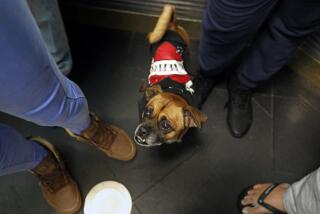Biting Back : Animal Researchers, Industries Go on the Offensive Against Increasingly Militant Activists
Three decades ago, when the animal rights movement was just reaching into public consciousness, its adherents airlifted wild burros marked for death from the Grand Canyon, stopped the clubbing of baby seals and took to the high seas to fend off whalers.
Now they do that and much more, from staging anti-fur parades to operating a frog dissection hot line to burglarizing laboratories and torching a multimillion-dollar research facility. They have sent furriers into economic shock, forced the withdrawal of untold thousands of dollars from federally funded animal experiments and compelled a growing number of companies to stop using animals to test for the safety of cosmetics and household products.
In the process, animal rights advocates have become the fastest-growing movement in the nation, at least by some counts. Up to 10 million people belong to groups ranging from the Humane Society of the United States, which stresses animal protection, to such lesser-known entities as Rat Allies and Feminists for Animal Rights.
But as animal advocates seek to turn what is still largely a protest movement into a long-term popular cause, they face a new and potentially devastating challenge.
The animal-using industries and professions that have borne the brunt of their attacks so far have launched a massive, multimillion-dollar counteroffensive. The vitriol that is now building on both sides raises two questions: Have animal rights activists gone too far? And how far will their opponents go to stop them?
The Fur Information Council of America, for example, has spent more than $2 million so far in a campaign that features, among other things, full-page newspaper advertisements that portray animal rightists as violence-prone radicals with a bizarre agenda for change.
“Today fur. Tomorrow leather. Then wool. Then meat. . . . After that, medical research. Even circuses and zoos,” read the ads, which were created by the public relations firm of Burson-Marsteller.
The council also tracks activities of animal rights groups. Photographs taken by fur retailers at demonstrations have been turned over to the U.S. Department of Justice, the council acknowledges.
The Cosmetic, Toiletry and Fragrance Assn. has amassed a war chest of almost $1 million for targeting legislators, news media and public-opinion makers in about 10 states where bills are being considered which would ban the use of animal testing for the safety of cosmetics and household products.
“We are in an escalating fight across the country,” E. Edward Kavanaugh, CTFA’s president, told members in announcing the plan. “We are not dealing with rational opponents. We are dealing with zealots who cannot comprehend that a child’s life is more important than a dog’s. . . .”
The American Medical Assn., a longtime foe of anti-vivisectionists, has adopted an “action plan” with a price tag of between $15 million and $35 million that is designed to “isolate the hard-core activists from the general public” by exploiting the differences within the movement over goals and tactics--particularly over the use of violence.
Among other efforts, the plan calls for challenging the tax-exempt status of certain nonprofit animal rights groups, forming a special investigative unit within the federal government to investigate animal rights activities and creating a so-called Foundation for Animal Health to draw funds away from animal rights organizations.
The AMA’s crusade got a big image boost when Health and Human Services Secretary Louis W. Sullivan, former dean of the Morehouse School of Medicine in Atlanta, recently vowed to lead the fight against “animal rights terrorists who have impeded life-enhancing research.”
The biomedical research field in particular has been galvanized. A group of beneficiaries of research on animals--Incurably Ill for Animal Research (IFAR)--have dedicated themselves to battling anti-vivisectionists by publicizing their own medical histories.
In response to what he terms “the constant barrage of lies about research programs,” Charles Nicoll, a Berkeley physiologist in endocrinology, two years ago formed the Coalition for Animals and Animal Research. The group, which organizes demonstrations and lectures backing animal-based research, has 20 affiliates on university campuses across the country and, says Nicoll, has received 300 requests for information on forming similar pro-research organizations.
Even as the backlash was building, some of the more militant members in the animal rights movement had suffered setbacks:
* A federal grand jury in Sacramento is investigating the Animal Liberation Front (ALF), a militant underground organization, in connection with break-ins throughout the University of California system and other Western research facilities.
* Later this year, Fran Trutt, a highly publicized animal rights activist, will stand trial on charges of attempted murder. She was arrested in November, 1988, with a pipe bomb outside the Connecticut offices of the United States Surgical Corp., which uses dogs to test surgical staples. Trutt and animal rights sympathizers maintain she was set up by agents of the surgical supply company.
* In November, the U.S. Senate unanimously passed a bill to make breaking into research facilities a federal crime. Two similar bills are pending in the House.
* In February, after protracted campaigning, voters defeated an initiative to ban the sale of furs in the trendy ski resort of Aspen, Colo.
Amid the controversy, American public opinion appears divided. A May, 1989, Louis Harris poll found more than 57% of respondents thought animal rights activists did more good than harm, versus 36% who thought the contrary.
A Gallup Poll, conducted for the AMA a year ago, showed 36% of those questioned strongly supported the use of animals in biomedical research and 23% strongly opposed it. However, 77% thought the use of animals in medical research was necessary for progress in medicine.
Finally, in a March, 1989, ABC News poll, 35% of the people said they wouldn’t like to own a fur coat because animals were killed, while 23% said the purchase price was prohibitive.
Such numbers dictate a clear strategy for the coalition of industry and professional groups that has begun to attack the animal rights cause: Concentrate on the issue of vandalism at biomedical research labs.
In the past decade, the Animal Liberation Front, which has been tagged as a terrorist group by the FBI and California Atty. Gen. John Van de Kamp, has claimed more than 100 raids against U.S. research laboratories, resulting in “liberated animals” plus $10 million in damages in destroyed equipment. In California, the state’s Biomedical Assn. estimates damages at $5.6 million, $4.5 million caused by the 1987 burning of an unfinished veterinary medicine building at UC Davis.
After a 1985 attack on the University of Arizona medical center where volunteers were testing a drug to help victims of multiple sclerosis, one MS patient founded the Incurably Ill for Animal Research, now a national association with 2,500 members.
“I wouldn’t be alive today if it were not for animals in medical research,” says Cyndi Jelkmann, president of IFAR’s Los Angeles chapter. A heart transplant patient, Jelkmann has benefited from transplantation techniques developed on dogs and sheep.
“It’s not a matter of statistics for us,” says IFAR national director Steve Caroll. “It’s a matter of life and death.” Burned over half of his body in an airplane crash, Caroll was saved through a skin graft technique first perfected on pigs.
Animal rights groups claim most of the experiments are repetitive, wasteful and unnecessary. Cheryl McAuliffe, state director of the Georgia Fund for Animals, said “about 90% of biomedical research has nothing to do with saving human or animal life.”
But it is the hard-line ideology of the most militant advocates that captures more of the attention: “A life is a life,” declares Chris DeRose, head of the Los Angeles-based activist group, Last Chance for Animals. “If the death of one rat cured all diseases it wouldn’t make any difference to me. In the scheme of life we’re equal.”
It is this kind of ideology that is provoking an equally hard-line reaction.
Dr. John Orem, a sleep researcher whose Texas Tech lab was raided by ALF last summer, says he has been “hardened to the animal rights movement. I had sympathy for their welfare concerns, but now I am against their concerns in all their forms. That is the danger of a backlash because you always risk overreacting.”
The February murder of Dr. Hyram Kitchen, dean of the University of Tennessee College of Veterinary Medicine, who was gunned down at his Knoxville home, has elicited extreme opinions among both animal rights activists and the biomedical research community. Although no evidence has been found and most observers believe none exists, the Federal Bureau of Investigation has been investigating a possible link between the death and animal rights activists.
Said Franklin Loew, dean of the School of Veterinary Medicine at Tufts University, referring to the Kitchen affair, “There are some people in the medical research community who in a bizarre and perverse way almost hope there is an animal rights link so that any critics of medical research, whether moderate or extreme, might be discredited.”
Both activists and pro-researchers allow that image is important in choosing which experiments to target. Loew points out, “There has not been a highly publicized break-in on cancer, heart disease, AIDS or Alzheimer’s research, four diseases most people would rank at the top of the health hit parade.”
On the other hand, the University of California system has been a major national target, even though DeRose says that other research institutions conduct less humane experiments on animals. But, he says, “UCLA is looked up to like a temple. Once it’s brought to its knees all the other universities will start to respond.”
Undeniably, activists have proved better able to grab newspaper column inches and media sound bites than their adversaries. As Loew points out, “It’s hard to make a researcher who discovers a new enzyme as sexy as accusing a guy from a blue-chip university of being a torturer.”
In describing their plight, advocates for the biomedical research camp also run the risk of hyperbole. A March Washington Times editorial stated that “scientists are dropping out of medical research like sparrows in a blizzard,” and quoted Richard Van Sluyters, a visual neuroscientist at Berkeley, as reporting “that 30% to 40% of undergraduates quit research careers out of fear.”
Van Sluyters confirms that about 30% of the half-dozen to dozen students who approached him last year about entering biomedical research studies were frightened away--or a maximum of four people.
The attacks come as no surprise to animal rights activists.
“Every social cause, no matter how justified, gets an angry backlash,” said Dr. Neal Barnard, chairman of the Physicians Committee for Responsible Medicine, a Washington-based anti-vivisectionist organization that has been in the forefront of the movement.
Many animal advocates, in fact, see the counter assault as the surest sign that their crusade is succeeding in its efforts to move into the mainstream.
“I look on their attack as an advantage,” said Regina Gavin, New York director of the Williamsport, Pa.-based Trans-Species Unlimited, which is a particular nemesis of the fur industry. “What it does is open up the public dialogue and bring out the issue even more than we could ever do ourselves.”
Although Trans-species encourages confrontational tactics as part of its anti-fur campaign, Gavin said that the group does not condone violence or civil disobedience.
Carol L. Burnett, a spokeswoman for People for the Ethical Treatment of Animals (PETA), a media contact for ALF, said that the counteroffensive was unlikely to bring about any changes in the strategies of her organization, which claims a membership of 280,000 people nationwide and boasts of being the biggest, most broadly active and among the most radical of the new-breed animal advocacy groups.
PETA officials point to a major upcoming vegetarian campaign, flagged by the ad slogan, “Meat Kills.” As forerunners at this latest barricade, activists spray-painted two McDonald’s outlets in suburban Washington in mid-March.
The extremist image of some animal advocates already is causing more moderate groups allied with the cause to disassociate themselves publicly from the more radical elements.
John Hoyt, president of the Washington-based Humane Society of the United States, for example, in a speech last month to animal agriculturists at a regional seminar in Maryland, took great pains to distinguish between groups like his that more correctly should be called “animal welfarist” or “animal protectionist” and those groups like PETA that are strict “animal rightists.”
Unlike animal rightists, who generally maintain that all animal exploitation is immoral and should be abolished, animal protectionists hold that some uses of animals for human needs are acceptable as long as the conditions under which the animals live and die are as free of unnecessary pain and suffering as possible.
The Humane Society’s Hoyt said that he has been moved in recent months to point out such distinctions because he believes that the extremist image of animal advocates is making it increasingly difficult to find common ground with sympathetic members of the animal farming community and the biomedical research Establishment.
Hoyt said, for example, that the “small farmer isn’t at all happy with agribusiness” and might be amenable to joining animal welfarists in encouraging more humane livestock and poultry production practices. Similarly, he added, there are members of the biomedical research Establishment who would be receptive to an alliance to achieve “reasonable reforms in using animals for testing and research procedures.”
But if they think of all animal advocates as coming from the same extremist mold, he said, they are going to be discouraged from entering any such unions simply as a matter of economic self-preservation.
A similar viewpoint is held by New Yorker Henry Spira, a 62-year-old former seaman, union activist and high school teacher who has been involved in the animal rights cause for the past 15 years and is one of the leading moderate figures in the national movement.
In his latest campaign, which is aimed at factory farming and uses East Coast poultry king Frank Perdue as a target, Spira promotes systems that will improve the quality of life for both animals and workers.
Spira has followed a similar strategy with great success in his previous campaigns, including his classic crusade against the cosmetic industry’s practice of testing new products in the eyes of rabbits. It opened publicly with a full-page advertisement in the New York Times that asked: “How Many Rabbits Does Revlon Blind for Beauty’s Sake?”
Similarly, his campaign against Perdue was launched last fall with an ad challenging Perdue’s claim that his animals live a pampered life in a kind of “chicken heaven.” “Frank, Are You Telling the Truth about Your Chickens?” asks the ad, which features a drawing of Perdue with a Pinnochio-like nose at the end of which are perched two baby chicks.
But even though they may not publicly disagree with Spira’s methods of operation, many radical animal rightists do not feel that the gradualist route is the way to go.
Radicals insist that the confrontational approach is necessary to keep the issue alive in the public mind. Otherwise, they argue, it runs the risk of being submerged by any of a number of other national issues.
Animal-using industries and professions generally are in no mood to temporize. They feel that they underestimated the movement when it started gathering momentum in the early 1980s and that it has already gained too much ground.
Irene Malbin, a spokeswoman for the Cosmetic, Toiletry and Fragrance Assn., contends that the bills pending in 10 states to ban animal testing for safety of consumer and household products spell trouble for the industry.
“Animal testing for product safety must remain as a scientific option,” she said. “It must not be legislated out of existence. If you didn’t have animal testing, you wouldn’t have products like sun screen, which reduces your chance of skin cancer.”
Despite the assertions of animal rights activists, she maintained, there are no alternatives to provide the kind of data necessary to substantiate the safety of many new products or new combinations of old products.
She says that if individual cosmetic companies desire to go to alternative methods of testing, that is their right. But, she added, the standpoint of the industry as a whole is that it must maintain the option of being able to use animals for testing--an option that should not be excluded by any kind of legislation.
Venant reported from Los Angeles and Treadwell from New York. Researchers Nina Green in Los Angeles, Edith Stanley in Atlanta and Lisa Phillips in New York contributed to this report.
More to Read
Sign up for Essential California
The most important California stories and recommendations in your inbox every morning.
You may occasionally receive promotional content from the Los Angeles Times.










